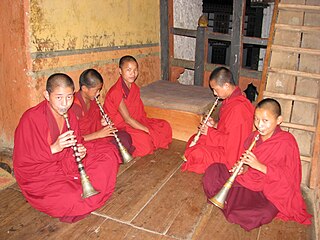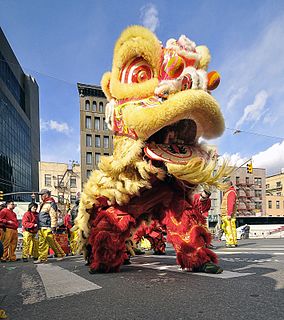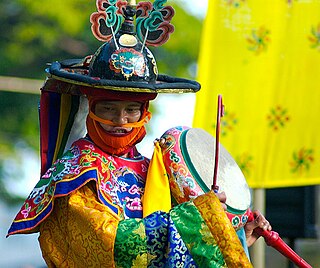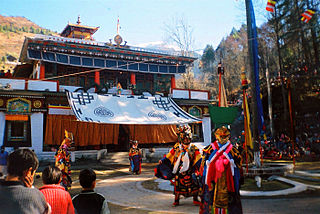
In some schools of Buddhism, bardo or antarābhava is an intermediate, transitional, or liminal state between death and rebirth. The concept arose soon after Gautama Buddha's death, with a number of earlier Buddhist schools accepting the existence of such an intermediate state, while other schools rejected it. The concept of antarābhava, an intervening state between death and rebirth, was brought into Buddhism from the Vedic-Upanishadic philosophical tradition. Later Buddhism expanded the bardo concept to six or more states of consciousness covering every stage of life and death. In Tibetan Buddhism, bardo is the central theme of the Bardo Thodol, the Tibetan Book of the Dead, a text intended to both guide the recently deceased person through the death bardo to gain a better rebirth and also to help their loved ones with the grieving process.
A tulku is a reincarnate custodian of a specific lineage of teachings in Tibetan Buddhism who is given empowerments and trained from a young age by students of his or her predecessor.

The music of Bhutan is an integral part of its culture and plays a leading role in transmitting social values. Traditional Bhutanese music includes a spectrum of subgenres, ranging from folk to religious song and music. Some genres of traditional Bhutanese music intertwine vocals, instrumentation, and theatre and dance, while others are mainly vocal or instrumental. The much older traditional genres are distinguished from modern popular music such as rigsar.

Lion dance is a form of traditional dance in Chinese culture and other Asian countries in which performers mimic a lion's movements in a lion costume to bring good luck and fortune. The lion dance is usually performed during the Chinese New Year and other Chinese traditional, cultural and religious festivals. It may also be performed at important occasions such as business opening events, special celebrations or wedding ceremonies, or may be used to honour special guests by the Chinese communities.

The Bardo Thodol, commonly known in the West as The Tibetan Book of the Dead, is a terma text from a larger corpus of teachings, the Profound Dharma of Self-Liberation through the Intention of the Peaceful and Wrathful Ones, revealed by Karma Lingpa (1326–1386). It is the best-known work of Nyingma literature. In 1927 the text was one of the first examples of both Tibetan and Vajrayana literature to be translated into a European language and arguably continues to this day to be the best known.

The Rai (exonym) or Khambu (endonym) are a Kirati indigenous ethnolinguistic group in Eastern Nepal, the Indian states of Sikkim and West Bengal and in south western Bhutan.

The Adi people are one of the most populous groups of indigenous peoples in the Indian state of Arunachal Pradesh. A few thousand are also found in the Tibet Autonomous Region where they are called the Lhoba together with some of the Nishi, Na, Galo, Mishmi people and Tagin people.

The Bhutia are a community of Sikkimese people living in the state of Sikkim in northeastern India, who speak Drenjongke or Sikkimese, a Tibetic language fairly mutually intelligible with standard Tibetan. In 2001, the Bhutia numbered around 60,300. Bhutia here refers to people of Tibetic ancestry. There are many clans within the Bhutia tribe and Inter-Clan marriages are preferred rather than marriages outside of the tribe.

Sky burial is a funeral practice in which a human corpse is placed on a mountaintop to decompose while exposed to the elements or to be eaten by scavenging animals, especially carrion birds. It is a specific type of the general practice of excarnation. It is practiced in the Chinese provinces and autonomous regions of Tibet, Qinghai, Sichuan and Inner Mongolia, as well as in Mongolia, Bhutan and parts of India such as Sikkim and Zanskar. The locations of preparation and sky burial are understood in the Vajrayana Buddhist traditions as charnel grounds. Comparable practices are part of Zoroastrian burial practices where deceased are exposed to the elements and birds of prey on stone structures called Dakhma. Few such places remain operational today due to religious marginalisation, urbanisation and the decimation of vulture populations.

The cham dance is a lively masked and costumed dance associated with some sects of Tibetan Buddhism and Buddhist festivals. The dance is accompanied by music played by monks using traditional Tibetan musical instruments. The dances often offer moral instruction relating to karuṇā (compassion) for sentient beings and are held to bring merit to all who perceive them.
Phowa is a tantric practice found in both Hinduism and Buddhism. It may be described as "transference of consciousness at the time of death", "mindstream transference", "the practice of conscious dying", or “enlightenment without meditation”(Wylie: ma-sgom sangs-rgyas ). In Tibetan Buddhism phowa is one of the Six yogas of Naropa and also appears in many other lineages and systems of teaching.

The Snow Lion is a celestial animal of Tibet. It is the emblem of Tibet, representing the snowy mountain ranges and glaciers of Tibet, and may also symbolize power and strength, and fearlessness and joy, east and the earth element. It is one of the Four Dignities. It ranges over the mountains, and is commonly pictured as being white with a turquoise mane. In Journey to the West published in 1592, Snow Lion is depicted as one of Yōkais .

The Psychedelic Experience: A Manual Based on The Tibetan Book of the Dead is a 1964 book about using psychedelic drugs that was coauthored by Timothy Leary, Ralph Metzner and Richard Alpert. All three authors had taken part in research investigating the therapeutic potential of psychedelic drugs such as LSD, psilocybin and mescaline in addition to the ability of these substances to sometimes induce religious and mystical states of consciousness.
In Tibetan Buddhism and Bön, Zhitro or Shitrozab-chos zhi khro dgongs pa rang grol, also known as kar-gling zhi-khro refers to a cycle of teachings revealed by the terton Karma Lingpa and traditionally believed to have been written by Padmasambhava. The practices involve a mandala of 100 peaceful (zhi) and wrathful (khro) tantric deities and associated teachings and tantric practices which focus on those deities which represent the purified elements of the body and mind. These hundred peaceful and wrathful deities are believed to manifest to a deceased person following the dissolution of the body and consciousness whilst they are in the intermediate state, or bardo, between death and rebirth. The Bardo Thodol, commonly known in the West as "The Tibetan Book of the Dead", forms one section of Karma Lingpa's Zhitro cycle. The Zhitro teachings are closely related to the Guhyagarbha Tantra and are considered an Inner Tantra.

There is widespread belief in ghosts in Tibetan culture. Ghosts are explicitly recognized in the Tibetan Buddhist religion as they were in Indian Buddhism, occupying a distinct but overlapping world to the human one, and feature in many traditional legends. When a human dies, after a period of uncertainty they may enter the ghost world. A hungry ghost has a tiny throat and huge stomach, and so can never be satisfied. Ghosts may be killed with a ritual dagger or caught in a spirit trap and burnt, thus releasing them to be reborn. Ghosts may also be exorcised, and an annual festival is held throughout Tibet for this purpose.
Singhi Chham or Kanchendzonga Dance is a lion dance form in Sikkim whereby the dancers perform in a lion costume that represents the snow lion. It is a dance of the Bhutia people, and was said to have been introduced by Chador Namgyal, the third Chogyal of Sikkim, in the 18th century. It is usually performed during the Panglapsool festival.

Guthuk is a noodle soup in Tibetan cuisine. It is eaten two days before Losar, the Tibetan New Year and is a variation on Thukpa bhatuk. The Tibetan religious ceremony 'Gutor' (དགུ་གཏོར་), literally meaning offering of the 29th, is held on the 29th of the 12th Tibetan month, and is focused on driving out all negativity, including evil spirits and misfortunes of the past year, and starting the new year in a peaceful and auspicious way. It is made with barley and other ingredients.

Tuting is a town, panchayat circle head quarter, assembly constituency, and Indian Military HQ on the bank of Brahmaputra at a distance of 34 km south of McMahon Line and 170 kilometres north of Yingkiong in Upper Siang district in the north-eastern state of Arunachal Pradesh in India. Tuting town is under the administration of an (ADC) Additional Deputy Commissioner. Tsangpo river (Brahmaputra) enters here from Tibet and natives know it as the Tsang Chu, downstream of here it is called the Siang river and Bramhaputra in Assam.

Lincoln in the Bardo is a 2017 experimental novel by American writer George Saunders. It is Saunders's first full-length novel and was the New York Times hardcover fiction bestseller for the week of March 5, 2017. Saunders is better known for his short stories, reporting and occasional essays.

Losoong is the Sikkimese New Year, of the Bhutia tribe, celebrated every year in the month of December.















